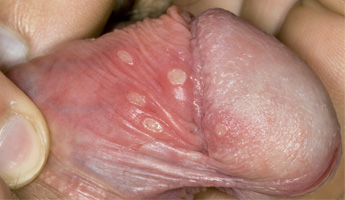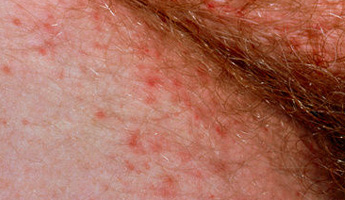Penis problems: a visual guide
If you’ve got a problem down below, you really need to go to your GP or a sexual health clinic to get it checked out. In the meantime, here’s a guide to some penis problems.
Visit 'penis problems: a visual guide' on NHS Choices.Itchy pubic area

Itchy red spots in the pubic hair region may be a sign of a pubic lice infection, also called crabs. Lice droppings can leave a dark-coloured powder on your skin or underwear. Blue spots, caused by lice bites, may appear on your skin.
You may notice nits, which are empty lice eggshells that look like white oval dots, attached to the base of your hairs. Pubic lice is usually easily treated with insecticide medicines available in most pharmacies.
More on pubic liceBlisters on your penis

Painful red blisters that burst to leave open sores on and around your penis could be a sign of genital herpes, a virus usually caught through sex. At least 8 out of 10 people with herpes don’t know they have it because there are often few or no initial symptoms.
The virus can get triggered later on, causing an outbreak of genital herpes. Although there is no cure, genital herpes can be effectively controlled using antiviral drugs.
More on genital herpesSpots on the penis

Spots or abnormal patches of skin on the penis could be a sign of molluscum contagiosum (MC). The lesions are usually 2-6mm across with a central dimple. They are usually firm, raised and painless and may appear in clusters. They may rupture to give out a yellowy-white substance.
MC usually clears up by itself, but treatment includes freezing with liquid nitrogen or squeezing out the central plug of each molluscum. Consult your GP or a sexual health clinic before trying this yourself. The virus is highly infectious and touching the lesions could cause it to spread.
More on molluscum contagiosumDischarge from the penis

It’s normal to produce some whitish or clear fluid from the tip of the penis when you’ve been sexually excited or first thing in the morning. However, a thick white, yellow or green discharge and pain when you pee may be symptoms of gonorrhoea or chlamydia, both sexually transmitted infections (STIs).
Both are easily treated with antibiotics. If left untreated, gonorrhoea and chlamydia can lead to serious long-term health problems and infertility, so if you’ve ever put yourself at risk of an STI, get yourself checked.
More on chlamydiaIntense itching

Intense itching around the sexual organs that gets worse at night when the body temperature is higher could be a symptom of scabies, caused by tiny red mites that burrow into the skin. Their bites can cause a skin rash, which if scratched can leave crusty sores.
Scabies is mainly spread through skin-to-skin contact and it can take up to eight weeks for symptoms to appear. Scabies is not usually serious and can be easily cured using a prescription cream or lotion.
More on scabiesSmall fleshy growths

Small fleshy growths that are firm and raised with a rough surface could be a sign of genital warts, caused by a virus usually caught through sex. Similar to the warts that appear on the hands, you can have a single wart or clusters of warts, with a cauliflower-like appearance.
Warts are usually painless although they can be itchy, particularly if they develop around the anus. Depending on the symptoms, genital warts are treated using prescription creams or by freezing.
More on genital wartsInflamed penis head

Swelling, redness and soreness of the head of the penis and lumpy discharge under the foreskin may be a sign of balanitis. Causes of balanitis include thrush, skin conditions such as eczema or psoriasis, germs building up under the foreskin, poor hygiene and unprotected sex.
Treatment may simply involve practising good hygiene and washing with plain water only, avoiding certain skin irritants such as perfumed soap, or using prescription creams if there’s an infection.
More on balanitisBent penis

A significant bend in the penis, which may cause pain or difficulty having sex, could be a symptom of Peyronie’s disease. Other signs include a thickened area or hard lump in the shaft of the penis.
Various non-surgical treatments are available, but there is little evidence to support their efficacy. Surgery is an option but it is not recommended immediately as the condition can sometimes improve on its own. Many men don’t need treatment as the condition may not cause them any discomfort.
More on Peyronie’s diseaseVisit the 'penis problems: a visual guide' on NHS Choices.
Find your local sexual health services
There are a number of places where you can get screened for sexually transmitted infections (STIs) including some GP surgeries, sexual health and contraception clinics. All these sexual health services are confidential and all advice, information and STI tests are free.
Enter your postcode to find your local sexual health servicesNHS Choices 2014